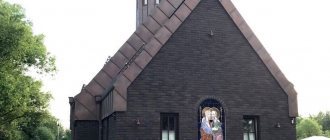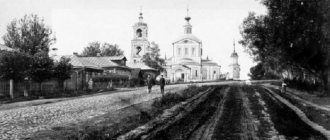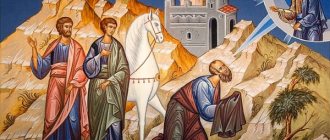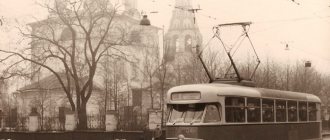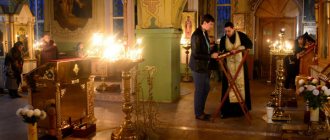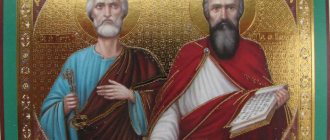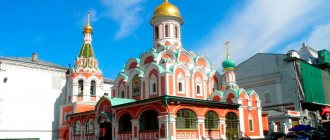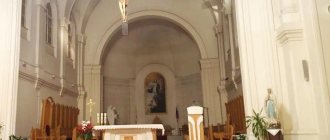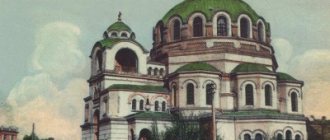Address: U. M. Jalil, 21
Opening hours: from 7.00 to 19.00
The year 1722 was widely celebrated in many cities of Russia. After all, it was the anniversary year of the Russian Emperor Peter the Great
, who is 50 years old. In addition to the usual festive celebrations, Orthodox churches were erected in many cities in honor of the emperor. In Nizhny Novgorod, for example, an amazing example of Russian baroque appeared - the Nativity Church, which today is a worthy architectural decoration of this ancient city. Kazan was enriched during this period with a beautiful Orthodox church - the Peter and Paul Cathedral, which became a truly unique example of regional temple construction of the Peter the Great era.
Peter and Paul Cathedral in Kazan is a unique example of Peter the Great's Baroque of the 18th century
The sponsor of this building was the local merchant I.A. Mikhlyaev
, who immortalized in this building not only the name of the Emperor of All Rus', but also his own surname. This temple is today one of the attractive tourist “highlights” of Kazan, which almost all guests of the city want to see and visit. All the powers that be visited this temple during their travels around Russia - emperors and travelers, writers and poets. The walls of the temple remember A. Dumas and A. Pushkin, F. Chaliapin and A. Humboldt.
Where it all started
Back in 1565 (think about this date!) a wooden church of Peter and Paul was built in the city, in which services were held for Christian believers.
The ambitious Tsar Peter 1, expanding the territory of the Russian state, visited Kazan three times: the first visit took place in 1695, when Peter 1 carried out the Azov campaign.
Later there was a second one - in 1708 - at the opening of a large admiralty in Kazan on the Volga.
And for the third time, while carrying out his campaign in Persia or, as historians also call it, the Caspian Campaign, Emperor Peter 1 again visited Kazan.
This time he was staying in the house of a well-known philanthropist in the city, merchant Ivan Mikhlyaev, the famous owner of a cloth factory. His two-story house was located right next to the ancient small Peter and Paul Church.
Interior decoration
The interior decoration of the cathedral is no less rich. There is an elegant combination of floral motifs and luxurious stucco throughout. Because of this original design, the temple has a second name - stone hanging gardens. Along the gallery there are unique antique tiles. This exclusive detail is the only one in the city. The overall picture is successfully completed with an iconostasis with seven tiers, distinguished by luxurious carvings.
It also happens!
These days Peter 1 turned 50 years old. And he celebrated this holiday in Kazan. In memory of such a significant event and expressing gratitude to the king for his trust, since he gave the merchant management of unprofitable production, the manufacturer decided to build a luxurious stone cathedral in the name of Saints Peter and Paul.
Using all possible local forces, the temple took four years to build. But during construction, the proportions of the high-rise building were incorrectly taken into account, and as a result, one night the dome of the church, which had been built for several years, simply collapsed. Of course, this terrible event came as a complete surprise to the builders.
But every cloud has a silver lining. Having heard about such troubles associated with the construction of the temple in Kazan, Peter 1, without hesitation for a long time, gave his royal order. And Moscow craftsmen arrived to help the Kazan builders, taking with them, again, by royal decree, Florentine architects.
And already in 1726, a solemn ceremony of consecration of the new Peter and Paul Cathedral took place. A commemorative inscription was made about this event, significant for everyone, on the cross, which before the revolution was preserved in the vast sacristy of the Orthodox cathedral.
The revival of shrines is a people's affair
Over the years of its existence, the temple survived 4 terrible fires, and in 1774 it was almost completely plundered during the days of the Pugachev uprising. All this caused him enormous damage, but each time, through the efforts and donations of parishioners, the Cathedral of Peter and Paul in Kazan was restored.
So, in 1815 there was a severe fire. The fire destroyed the entire lower church and the chapels on the first two floors, but the huge iconostasis of the main church was preserved only by a miracle.
The revival of shrines took place mainly with the money of wealthy parishioners. After the disaster of 1815, the merchant Zaitsev donated a large sum of money for restoration, and in 1824, after another similar disaster, the merchant Unzhenin became a benefactor.
Throughout the 19th century, his descendants then took care of the well-being of a significant city temple and, at the same time, a historical monument.
There was a constant collection of donations to keep the cathedral in good condition, and by 1864 a decent amount had been raised for this purpose.
With this money, the iconostasis was recreated in its original form: it cost 11,000 silver rubles. The altar was also reborn: the throne, the altar and the beautiful carved canopy, covered with gold, were revived in it. It rose above the altar in the middle of the altar and was supported by four columns.
The wall images, decorated with stucco, having been badly damaged by time and terrible fires, were also updated. These works cost 1225 rubles.
But the restoration affected only the interior of the cathedral. At the same time, its walls were so dilapidated that at any hour and moment they could simply collapse, and then only ruins would remain on the site of the Kazan Church of Peter and Paul.
The rector of the Peter and Paul Cathedral collected money bit by bit for external work to restore the temple. He personally gave 18,000 rubles of his own money for this.
And in 1889, a grandiose revival of the Kazan shrine began according to a project proposed by the architect M. Litvinov. It is known that he later became the caretaker of the Moscow building of the Cathedral of Christ the Savior.
A gift that has survived centuries
At the same time, the two-story aisle on the north was completely dismantled and rebuilt from brick, and the open western gallery was rebuilt. The most important task of the builders was to carefully lay a completely new foundation under the dilapidated walls of the renovated bell tower and the temple itself.
Along the way, all the cracks in the old walls were eliminated, and the dilapidated stones, which had already begun to crumble over time, were replaced with new ones. Thanks to this jewelry work of master builders, the Kazan Cathedral of the Supreme Apostles Peter and Paul has been one of the main attractions of the city for several centuries.
At the same time, the craftsmen renewed all the external stucco molding and all the icons, and there were 87 of them on the facade of the building and 4 more adorned the bell tower.
The gilding on the crosses was also updated, and the roof was painted in two colors in a checkerboard pattern.
A furnace was placed under the floor of the lowest floor, which supplied heat through pipes to the upper temple. Colored glass appeared in the windows; they repeated the shape of a cross.
Below the bell tower there was a chapel that served as the family crypt of Mikhlyaev, the creator of the Cathedral of Saints Peter and Paul. Everything was updated there, and it began to look about the same as before.
A clock has been placed on the bell tower for a long time. Over time, all that was left of them was a non-working dial. Therefore, new chimes were placed in this place, counting the time.
The entrance to the bell tower was separate. The street in front of the cathedral was paved with cobblestones, and the wrought-iron fence was beautifully decorated with icons.
Architectural features
The Orthodox pearl of the capital of Tatarstan is a real decoration of the city! The luxurious temple stands on an elevated place and is therefore visible from afar. The original decor and bright colors of the facades make it stand out from the surrounding buildings. The majestic baroque temple has many theatrical effects that are designed to impress the audience. It is no coincidence that all guests of Kazan admired and continue to admire the Cathedral of Peter and Paul!
Initially, the entrance to the temple was located from the Spasskaya Tower
. It is from the north that the main facade of the cathedral is located. Then this part of the city was built up with houses, and today the church is entered from the south.
On the north-eastern side of the temple there is a slender six-tiered bell tower 49 m high. The multi-colored decor of the tall building is in no way inferior to the design of the cathedral. The windows of the bell tower are decorated with elegant kokoshniks and colored tiles. In pre-revolutionary times, 10 bells hung on the bell tower, the largest of which weighed 189 pounds, that is, almost 3100 kg.
To the west of the temple stands the oldest civil building in the city - the stone mansion of the merchant Mikhlyaev, which was erected in the 17th century. This is exactly the house where Peter I stayed in 1722.
What was here before
Before the revolution, 10 bells called believers to Services in the temple. Some bore commemorative inscriptions indicating the maker and weight of the bell. Numerous shrines from religious buildings closed in those years were kept in the church sacristy.
These were, for example, 3 altar crosses with pearl inserts, richly decorated with numerous emeralds and other precious stones; The Gospel has existed since 1681 with five fractions. This is the name given to the miniature inserts that decorate the binding of a book. This Gospel was decorated with blue yacht and other semi-precious stones.
Mikhlyaev then donated to his creation an elegant silver censer, repeating the shape of the cathedral and other richly decorated church utensils, magnificent works of art.
The liar of Peter 1 is considered a significant value of the Peter and Paul Church. A liar is a special spoon made of gold, silver, tin or other metal with a cross at the end. Most often it was used during communion in our churches. Peter 1 personally gave this liar to the merchant Mikhlyaev as the owner who received him in his house.
The analogue icon of Saints Peter and Paul, a huge chandelier, consisting of 5 tiers and weighing 800 kilograms, illuminated the church with its 40 candles - all these things were donated by the merchant Mikhlyaev.
Of course, many ancient icons were solemnly preserved and revered by believers in the temple. Currently, the fate of many relics is unknown.
1917 has arrived - the year of the revolution
Starting from Catherine 2, at one time almost all the emperors of the Russian state, except Nicholas 2, visited the Peter and Paul Cathedral of Kazan. Many famous people of past years visited there, regardless of what faith they were committed to. This is Alexander Dumas, who described the Peter and Paul Church in one of his novels, and Alexander Pushkin, and Fyodor Chaliapin himself sang in the church choir!
Immediately after the revolution in Russia, the temple remained open to believers. But in 1930, an event occurred that led to catastrophic consequences. The rector of the cathedral was arrested for anti-Soviet activities. This “activity” consisted in the fact that the archpriest asked for financial assistance from the former citizen of Kazan Unzhenin, who after the revolution moved to live in China.
Unzhenin sent money, the community received help, but the clergyman was sent to a correctional camp for this. And then it began! Suddenly it was decided to urgently close the temple, since additional living space was needed, as well as premises for organizations.
It was planned to set up an anti-religious museum on the first floor of the huge building, and on the second floor to install Foucault’s astronomical pendulum and hold lectures and other events. At the same time, there was a gradual closure of all the surrounding monasteries and churches, so all the shrines, icons, and all utensils were brought here, to the still working Peter and Paul Cathedral.
In 1939 the temple ceased its work. The building housed the party archive, and later a planetarium. The religious community was moved to the Cemetery Church, which had previously been empty. Billiards were installed in the upper temple, and where there was an altar there was now a meeting hall.
Social service
There is a social service at the Kazan Peter and Paul Cathedral, under the leadership of the assistant rector of the temple, M. A. Mudra.
The service works with certain social groups - large families, single-parent or dysfunctional families, single disabled and elderly people, people without a place of residence. In addition to psychological assistance and moral support, those who apply also receive material assistance with food, things, and everything that parishioners donate.
In addition, some parishioners themselves provide all possible assistance to those in need, both material and necessary help with housework, which is very important and necessary for vulnerable groups of the population.
Meetings with the community are held monthly, where pressing problems are resolved to provide assistance to those who need it.
Anyone who cares can make a contribution and help people. Details for donations are on the official website of the Kazan Peter and Paul Cathedral and are presented below.
Details for donations
Shrines of the cathedral
This went on for about 50 years. At the end of the 80s of the 20th century, the cathedral was returned to the Diocese of Kazan. Its consecration took place in 1989.
Immediately, first of all, the carving of the seven-tiered iconostasis, the main 25-meter decoration of the temple, was restored, the royal doors were updated and, as far as possible, the roof and facade were restored.
A little later, a 50-meter, six-tier bell tower was erected, decorated with star-shaped tiles and white stone kokoshniks. A new clock was installed on the 5th tier.
To get to the 52-meter cathedral you need to walk along a high, wide staircase. It’s very beautiful, majestic, and you immediately have a premonition of some kind of festive celebration.
Finding yourself on the second floor, you get the feeling that you are already rising above the world, breaking away from all worldly worries.
The pride of the temple is the 25-meter iconostasis, consisting of 7 tiers.
The icons in it have a gold background. After several fires during its existence, the Images were restored. And only one - the temple icon of Saints Peter and Paul - has been preserved in its original form.
In the cathedral church, consecrated in the name of the Presentation of the Lord, the relics of St. Ephraim are kept. At one time, it was he who blessed Minin and Pozharsky for their campaign in Moscow, which marked the beginning of the expulsion of foreigners from Russian land. He also crowned Mikhail Romanov, the first king of this famous dynasty.
Here believers can pray to the myrrh-streaming Iveron Icon of the Mother of God.
In the Peter and Paul Church, its upper temple, the relics of father and son are placed for the veneration of parishioners: Saints Jonah and Nektarios of Kazan. Also in the cathedral are the relics of the revered Bishop of Jerusalem - Arseny and the revered miraculous Smolensk-Sedmiozernaya Icon of the Mother of God, which, according to legend, saved the inhabitants of Kazan from the plague in the 17th century.
The shrines that are located here, in general, are few in number, but they are very revered by believers.
General information
The church is located on a hill, so it is clearly visible from various points. It has a beautiful, majestic appearance and attracts many admiring glances. The spectacular architectural ensemble includes the cathedral itself, a 49-meter bell tower, the Mikhlyaev House and the Parable. Throughout its existence, the structure was often subject to fire. It was destroyed by the Pugachevites. But every time it was restored.
The year 1917 is significant in that the temple was under the leadership of the Central Museum of the TASSR with the aim of housing exhibitions of the anti-religious museum and lecture hall. Later, the Partarchive, planetarium, and restoration workshops began to function here. At the end of the 1980s. the shrine was returned to Orthodoxy. A wide range of restoration work was carried out. 1997, 2005 - these are the periods of worship of Patriarch Alexy II.
Attractions nearby
Next to the cathedral stands the oldest building in Kazan - this is the house of the merchant Mikhlyaev, built in the 17th century. The walls of this particular house saw the Russian Emperor Peter 1; it was here that he spent several days when he was visiting Kazan.
Can you imagine how many wars, joyful and tragic events took place here over the years of the existence of this building, how many natural disasters it survived and still stands, did not fall or collapse. Yes, old, dilapidated, but the whole history of Kazan passed before him!
Previously, the house had a direct passage to the temple. On the other side, the Church of Cosmas and Damian adjoined it. After his death, Mikhlyaev named the cathedral as the owner of his house. But later it turned out that the will was not executed correctly. For this reason, the descendants of the merchant began to manage the house.
And within walking distance from the Peter and Paul Church is the main attraction of Kazan - the Kazan Kremlin, as well as the legendary pedestrian Bauman Street.
That's how many beautiful, amazing and educational things you can see in the capital of Tatarstan - Kazan. Of course, this is not all there is to the city, rich in historical events. In our Russia, and in particular in Kazan, there are many attractions that are closely connected with the eventful history of the country.
Architecture
We all know that not every monument instantly acquires a finished appearance. Sometimes centuries-long renovations are required to achieve the desired image. Mostly the final look is achieved through the fruitful work of an experienced team of craftsmen. Restorers may periodically intervene in this process, since over time human activity leaves its mark. This is precisely the situation that has developed with the Peter and Paul Cathedral.
It did not acquire its greatness and beauty immediately. Moreover, the construction process itself began unsuccessfully. Most likely, the proportional features were not observed. At a high altitude, the structures could not cope with the load and collapsed. Local architects did not have sufficient experience. Fortunately, specialists with experience arrived from Moscow and made the correct calculations.
The monastery is distinguished by the presence of magnificent baroque attire. It is richly decorated. It is often inadvertently compared with the church in Fili and Stroganovskaya. The decorative decoration amazes the imagination of observers.
The architecture has a special composition. The object was built according to the scheme of a tier on a quadrangle. It is mounted on a fairly high base and has a tetrahedron with an octagon. The overall composition is completed by a baroque vault equipped with two domes. The building skillfully intertwines two directions - Russian and “Naryshkin” baroque. This solution was in high demand in the 17-18th century. On the western side there is a refectory.
The total height of the structure is 52 meters. From the west you can see the splendor of the arcade, the roof of which acts as a walkway with two rises. In the east there are limits that were made in the 1890s.
The design of the facades is distinguished by the presence of single and paired blades, pilasters, platbands, cornices, and stucco moldings. The leading decorative motif is a variety of beautiful flowers, leaves, branches with peaches, pears, and plums. They effectively frame both sides of the opening.
The eastern façade has one window. There once was a large icon here - the Mother of God on a throne surrounded by saints.” Both rows of openings are mounted in carved frames. The dome and roof are distinguished by the presence of a checkerboard design. The lush design harmonizes well with the polychrome color scheme. Compared to such grandeur, the bell tower has a more restrained decor. It is decorated with elegant, loose profiled cornices.
The luxurious bell tower deserves special attention. The spectacular multi-tiered tower was built almost simultaneously. The same specialists were involved in the entire process. The decorated bell tower strenuously rushes upward. On the second tier of the building there are deep areas for statues.
Where is it, how to get there
The Peter and Paul Church of the beautiful city of Kazan is very beautiful and unusual, it is located at the address: Musa Jalil, 21. Before the revolutionary events in Russia, this street was named after the temple - Petropavlovskaya.
Coordinates: 55.79346, 49.1132. You can get to it by any transport in the city. You will need to get off at the Kremlyovskaya stop.
Then you can walk along Bauman Street. Near the monument to the legendary Kazan Cat, you should turn left and climb a small hill. You can also walk from the Kremlin along Kremlevskaya Street. Near the Geological Museum. A.A. Shtukenberg there will be a right turn onto Musa Jalil Street. Here you will already see a sign and a fence, behind which the Church of Peter and Paul is located.
The schedule of services is unchanged; they are held here daily. The liturgy on weekdays begins at 8:00, and on Sundays and holidays - at 7:00 and 8:40. Evening service is held at 17:00. The cathedral territory is open all day for viewing, but it is better to come from 7.30 to 19.
Look at the location of the Peter and Paul Cathedral in Kazan on the map (click “+” to zoom in on objects or “-“ to zoom out).
The city of Kazan has many accommodation options to stay for a few days. It’s very easy to rent an apartment or room on Airbnb, or book a hotel through Booking.
My trip to the Cathedral of the Supreme Apostles Peter and Paul took place on July 24, 2022. Other sights of Kazan and its environs, where I was able to visit, are on this map. And their detailed description can be found here.
Share in the comments which Kazan monasteries and churches you have already visited and which of them made the most unforgettable impression.
